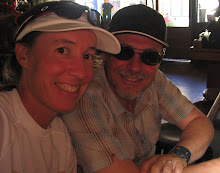 Journal entry 10/24 : I hear a rustling of thick plastic packaging in the cot next to me. Our food is there, and so is something else. I see the tail flash as I look over our bags of food with my headlamp. A mouse! I put on my headlamp, grab the bag, slip on my sneakers, and walk out the door. In the freezing dusty wind I untie the bag and dump the contents on the ground. The mouse, startled among the packages of nuts and peppered tofu, pauses in the lamp beam a moment before running off. I get back into the room and climb back into my sleeping bag. I hope there are no more disturbances tonight as I want a good night sleep. Tomorrow I begin the kora of Mt Kailash (our Tibetan driver calls it Kailashi). This is the mountain that began this crazy idea of a trip. This is the mountain whose image stuck in my mind for years and years, never letting me go. I know I am meant to come here. Well, for tomorrow, I prey for the enlightenment of all beings. I hope that you, Kailash, will dissolve the bad karma I have accumulated in this life, and in past lives. I prey that you will teach me as I walk around you, and you will bless me with your essence to take home and share with others.
Journal entry 10/24 : I hear a rustling of thick plastic packaging in the cot next to me. Our food is there, and so is something else. I see the tail flash as I look over our bags of food with my headlamp. A mouse! I put on my headlamp, grab the bag, slip on my sneakers, and walk out the door. In the freezing dusty wind I untie the bag and dump the contents on the ground. The mouse, startled among the packages of nuts and peppered tofu, pauses in the lamp beam a moment before running off. I get back into the room and climb back into my sleeping bag. I hope there are no more disturbances tonight as I want a good night sleep. Tomorrow I begin the kora of Mt Kailash (our Tibetan driver calls it Kailashi). This is the mountain that began this crazy idea of a trip. This is the mountain whose image stuck in my mind for years and years, never letting me go. I know I am meant to come here. Well, for tomorrow, I prey for the enlightenment of all beings. I hope that you, Kailash, will dissolve the bad karma I have accumulated in this life, and in past lives. I prey that you will teach me as I walk around you, and you will bless me with your essence to take home and share with others.A little background : Mt Kailash, or Gan Rinpoch, may arguably be the most sacred mountain in the world (Mt Sinai is the only other one even close). The Mountain holds a divine place in Buddhists, Hindus, Jains and Bön-Po religions. Every summer thousands and thousands of devout pilgrims, from across South and East Asia, make the difficult journey to this remote spot to walk the kora around the mountain. It is said that Buddha left an active mandala here, and the sacred vibe or energy around this mountain is so strong it is almost visible.
 In this blog entry I am simply putting my daily journal entries during our trip to, around, and from Kailash. For a more detailed description of sacred Kailash and the kora route, take a look at this excellent essay: http://www.passages.org.uk/essays/kailas/index.html
In this blog entry I am simply putting my daily journal entries during our trip to, around, and from Kailash. For a more detailed description of sacred Kailash and the kora route, take a look at this excellent essay: http://www.passages.org.uk/essays/kailas/index.htmlNow, back up a few days -
Journal entry 10/21 : After breakfast at Cafe Nomad, we were picked up at 8:30 by our driver and started the 4 day drive west. We drove past several beautiful monastery/temples. It seems that every little village has a monastery!
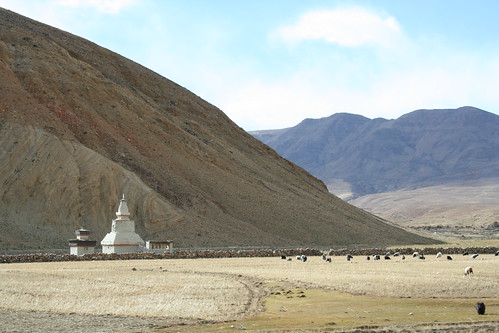 Into Shigatze for lunch. This city has a huge monastery/temple. After lunch we drove to Lhatse, jumbled town, but we found a hotel and were told it was "very clean" compared to what lies ahead. The drive was on the new paved road, but very slow because of all the police checkpoints. We ate at a Tibetan restaurant and met some Austrians. Shared a bottle of wine. It's cold.
Into Shigatze for lunch. This city has a huge monastery/temple. After lunch we drove to Lhatse, jumbled town, but we found a hotel and were told it was "very clean" compared to what lies ahead. The drive was on the new paved road, but very slow because of all the police checkpoints. We ate at a Tibetan restaurant and met some Austrians. Shared a bottle of wine. It's cold. 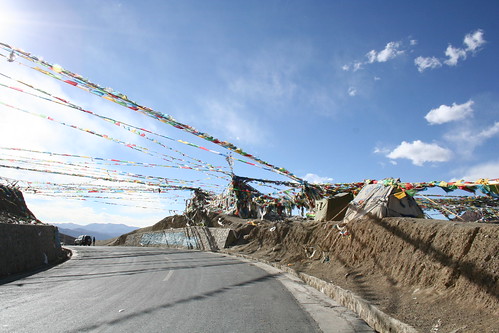 Stopped for lunch (yak butter tea and beef noodle) at a family's house.
Stopped for lunch (yak butter tea and beef noodle) at a family's house. 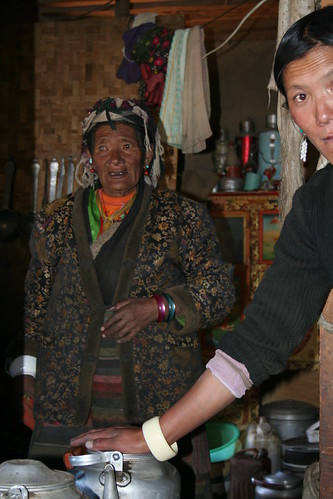 Cold and very windy. Driving on... we got a hotel (with warm electric blanket!) in Saga. Rod got altitude headache (4800m) and I am feeling sick with a cold. Saga gets on the list of worlds most crappie cities. The Chinese have come into the nice Tibetan villages and built ugly cheep buildings and destroyed any charm.
Cold and very windy. Driving on... we got a hotel (with warm electric blanket!) in Saga. Rod got altitude headache (4800m) and I am feeling sick with a cold. Saga gets on the list of worlds most crappie cities. The Chinese have come into the nice Tibetan villages and built ugly cheep buildings and destroyed any charm. 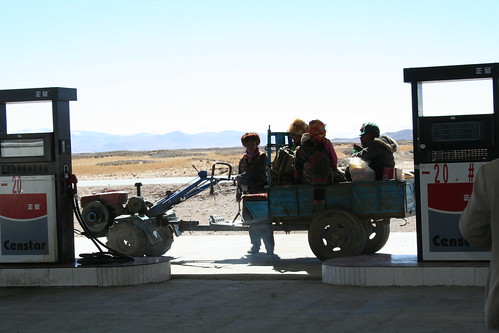 and saw a group of 4 people walking with baskets on their backs behind 6 packed up Yaks... real Tibetan Plateau Nomads! Had lunch at an adobe house/hotel with some Czechs who just did the Kailash kora. They said it was cold and dirty. We drove to the very pour and dirty village of Paryang. Settled in then sat reading in the sun outside until dinner time.
and saw a group of 4 people walking with baskets on their backs behind 6 packed up Yaks... real Tibetan Plateau Nomads! Had lunch at an adobe house/hotel with some Czechs who just did the Kailash kora. They said it was cold and dirty. We drove to the very pour and dirty village of Paryang. Settled in then sat reading in the sun outside until dinner time.  At the restaurant saw 2 cyclists arrive... wow! Riding these roads over such long distances and hard conditions! Sleep in our little cold room.
At the restaurant saw 2 cyclists arrive... wow! Riding these roads over such long distances and hard conditions! Sleep in our little cold room. 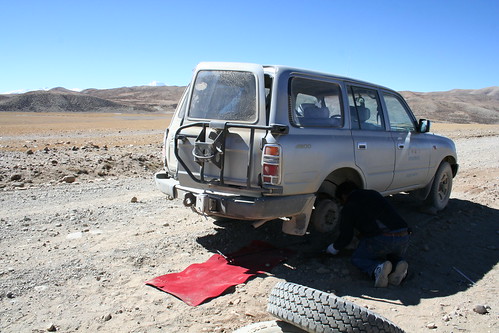 Finally drove up to Chiu monastery above the sacred Manasarovar Lake. MAGICAL! The flags up on the rocks, prayer wheels, carved stones, yak skulls. We could see Kailash just across the valley.
Finally drove up to Chiu monastery above the sacred Manasarovar Lake. MAGICAL! The flags up on the rocks, prayer wheels, carved stones, yak skulls. We could see Kailash just across the valley. 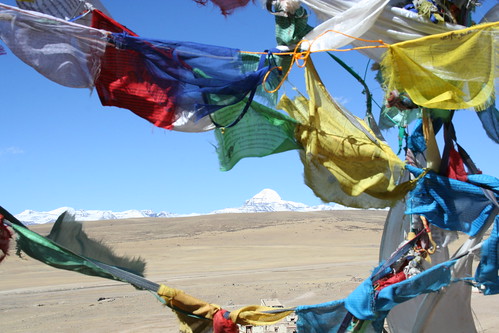 We got a room in Darchen and walked around the dirty town.
We got a room in Darchen and walked around the dirty town.  We are here after the 'official season' has ended, so there are only a few other tourists/pilgrims. But, dinner with two people just back from the kora, glowing. We start tomorrow.
We are here after the 'official season' has ended, so there are only a few other tourists/pilgrims. But, dinner with two people just back from the kora, glowing. We start tomorrow. This morning we started the Mt Kailash kora. A freezing morning in the guesthouse after a night of many shivers and little sleep. We walked through town to the 108 prayer wheels.
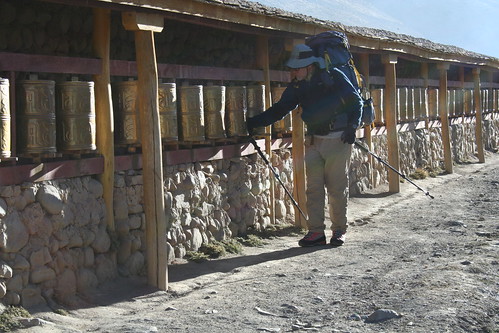 My glove-covered hand spun each wheel as the sacred walking meditation began (clockwise). We walked along the dry path as the sun got warmer, stopping at the first 'prostration point'.
My glove-covered hand spun each wheel as the sacred walking meditation began (clockwise). We walked along the dry path as the sun got warmer, stopping at the first 'prostration point'. 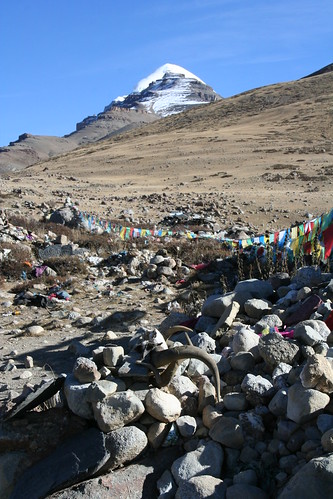 Om mani padme hum. Prayer flags and carved stones framed our first view of Kailashi. The pure white of the glaciers beaming over the dark sheer rocks.
Om mani padme hum. Prayer flags and carved stones framed our first view of Kailashi. The pure white of the glaciers beaming over the dark sheer rocks.
As we continued up the long valley along the West side of the mountain we passed endless carved stones and prayer flags. The peak came in and out of view, with each new view point marked by prayers flying in the icy wind. Holding my 108 prayer beads, I chanted my prayers to Kailashi. I preyed for the enlightenment of all beings, in particular my friends and family, and for the dissolution of my bad karma from this life and past ones. Tomorrow I will repeat all these. 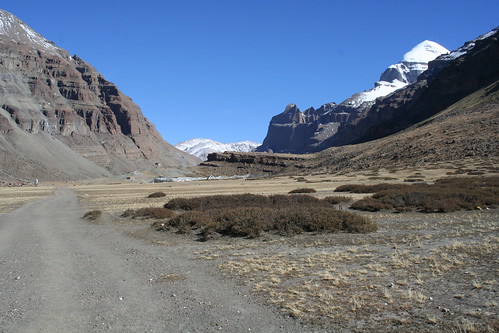 After lunch, we came to a big rock face that marks the Northwest ridge of the mountain. Here the trail gets closest to the rock massif. We dropped our packs and walked up to the wall. I did the prostration motions I saw in Lhasa on the side of the mountain, three times. I preyed for enlightenment of all beings and for dissolution of my bad karma. I touched both hands to the wall.
After lunch, we came to a big rock face that marks the Northwest ridge of the mountain. Here the trail gets closest to the rock massif. We dropped our packs and walked up to the wall. I did the prostration motions I saw in Lhasa on the side of the mountain, three times. I preyed for enlightenment of all beings and for dissolution of my bad karma. I touched both hands to the wall.
We passed a monastery, or gompa, high on the opposite hillside, the Chuku Gompa. 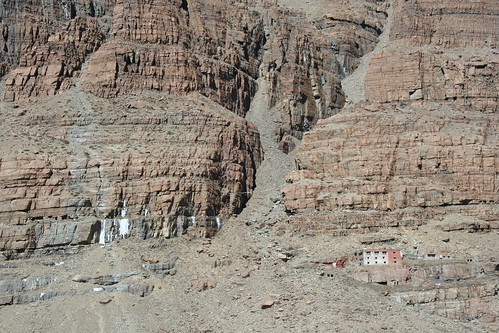 The area around it was scattered with caves. These are the super charged places. I would love to visit them, but I'm getting tired. Someday I come back, maybe. I filled up our water bottles under the big walls. I took photos of mountains, icefalls, birds, deer, yaks. I meditated. I walked. We finally made it to the Dira Phuk Gompa... and to our guest house. Both are basking in the unreal view of the North face of Kailash. So steep and sharp and powerful.
The area around it was scattered with caves. These are the super charged places. I would love to visit them, but I'm getting tired. Someday I come back, maybe. I filled up our water bottles under the big walls. I took photos of mountains, icefalls, birds, deer, yaks. I meditated. I walked. We finally made it to the Dira Phuk Gompa... and to our guest house. Both are basking in the unreal view of the North face of Kailash. So steep and sharp and powerful. 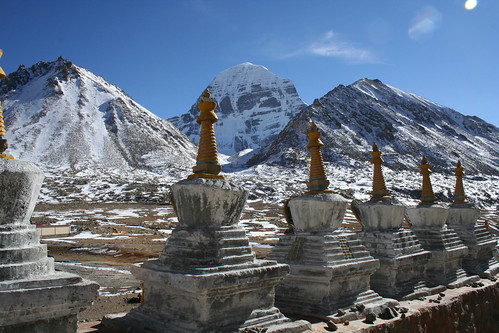 The monastery has many chortens (stupas) outside and prayer flags, all facing the mountain. It is funny; the monks like to come down to the guest house because it is run by two young women. They sit in the kitchen/dining/lounging room and drink yak butter tea and eat tortillas (well, I'm sure they have a Tibetan name) and flirt with the women. We fixed dinner and sat in that room too, because it is the only room with heat or light, and enjoyed watching the drama.
The monastery has many chortens (stupas) outside and prayer flags, all facing the mountain. It is funny; the monks like to come down to the guest house because it is run by two young women. They sit in the kitchen/dining/lounging room and drink yak butter tea and eat tortillas (well, I'm sure they have a Tibetan name) and flirt with the women. We fixed dinner and sat in that room too, because it is the only room with heat or light, and enjoyed watching the drama.
Suddenly there was some commotion outside. I walked out to see two herds of Yaks, loaded up with bags and blankets, being driven by men yelping and haa-ing. The yaks had blankets over their backs and the men wore traditional cloths and red traditional boots. 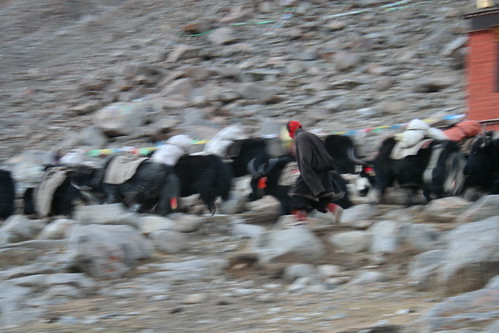 Two of the Yakmen came into the warm guest house room. They were dirty and shy. They had some warm butter tea and asked if they could stay here for the night. They pitched their tents and herded the Yaks together for sleeping. When inside our room getting ready for bed, I remembered I must plant my seed today. So, I went out into the icy wind in my long underwear to scratch a hole in Kailash dirt and bury my paper, moonrise.
Two of the Yakmen came into the warm guest house room. They were dirty and shy. They had some warm butter tea and asked if they could stay here for the night. They pitched their tents and herded the Yaks together for sleeping. When inside our room getting ready for bed, I remembered I must plant my seed today. So, I went out into the icy wind in my long underwear to scratch a hole in Kailash dirt and bury my paper, moonrise.
Journal entry 10/26 : The morning has been very cold. Very cold across the river and very cold up the valley to the Northwest of Kailash. 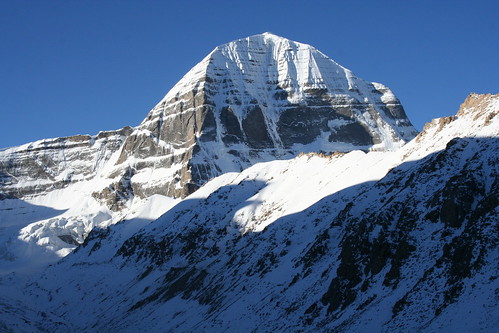 I tried to get connected and do some prayers, but the intense cold kept me focused on just walking. When we emerged over a knoll we entered the sunshine! Finally! We stopped to make tea. I have heard that during the 'summer season' there are tents and stands selling tea and snacks to pilgrims along the kora. We are walking unusually late in the year, so we have to deal with the cold, but also get to have the trail unmarred by enterprising folk... or even other hikers, only a few other pilgrims the whole kora! After tea and some food we continued up to the pass summit (5600 m). I left my hat, and past life, for Kailash to hold on to and bless, then made an offering of water, rice, and incense. When I walked away, I didn't look back.
I tried to get connected and do some prayers, but the intense cold kept me focused on just walking. When we emerged over a knoll we entered the sunshine! Finally! We stopped to make tea. I have heard that during the 'summer season' there are tents and stands selling tea and snacks to pilgrims along the kora. We are walking unusually late in the year, so we have to deal with the cold, but also get to have the trail unmarred by enterprising folk... or even other hikers, only a few other pilgrims the whole kora! After tea and some food we continued up to the pass summit (5600 m). I left my hat, and past life, for Kailash to hold on to and bless, then made an offering of water, rice, and incense. When I walked away, I didn't look back.
As I walked back toward Rod, a dog who had come with some other pilgrims (who were doing the 50km kora in one day!), was still lying there, and started to whine. It then got up and hobbled down the rocks. It's back right leg was in really bad shape. It must have post-holed through the snow to the rocks below and twisted or pinned its ankle. The ankle was completely broken and only attached by skin. The pour boy was hobbling on the stump of leg and bleeding down the pass. His people were way ahead, not waiting. Later they stopped and tied a rag around the wound, but the dog had to negotiate slippery ice and big rocks for ~20km back to the town... and then what? With its leg/paw flopping every step... it was very upsetting. We tried to give it some meat to eat when we caught up with it, but it wouldn’t eat. We tried to give it some water later, but it wouldn’t drink, only ate snow. Its people were so far ahead now, and it was slowing down and loosing blood. I watched it walking near us for several hours incase it collapsed, but when we crossed the river, we lost sight of it, and never saw it again. Sitting here tonight I think it is probably collapsed and freezing somewhere behind us. Poor dog. Suffering and trying to stay with its people. My new life from Kailash, with my regrets left behind, began with the saddest suffering sweet loyal dog who probably never made it. Suffering. So, second day of Kailash kora was emotional. Kailash gave me a teaching. This dog suffering through it's kora, and I couldn’t do anything to help, and I have to forgive myself for it. Not hold regrets about the dog, I have to accept its suffering and be thankful to it for bringing out my love. It challenged me the whole way down into a new life.
Now I am sitting in bed after dinner and hot Tang. We walked into the Zutrul Phuk monastery at 6:00 and the friendly monk brought us hot water. Our room is 5 cots around a low table.  A dirt floor, and dirt walls with cracks in them, one window, and wood beams on the ceiling. The beams have small wood slats connecting them, then grass matting on top of that. Above that is more dirt so the roof is a dirt floor that can be walked on. There are similar rooms on both sides of ours, and a temple up the steps to the left of the courtyard that our door opens to. The monk played a drum as the sun went down. I hope the dog made it back to town. Full moon on a windy night.
A dirt floor, and dirt walls with cracks in them, one window, and wood beams on the ceiling. The beams have small wood slats connecting them, then grass matting on top of that. Above that is more dirt so the roof is a dirt floor that can be walked on. There are similar rooms on both sides of ours, and a temple up the steps to the left of the courtyard that our door opens to. The monk played a drum as the sun went down. I hope the dog made it back to town. Full moon on a windy night.
Journal entry 10/27 : The last day of the kora, we slept in and felt comfortable in our mud room at the monastery. The monk let me inside the temple part; so many paintings of individual lamas on hanging fabrics, "thangkas". And there was a cave in the back. I turned the prayer wheels and put a white scarf in the cave for the dog. Then we packed up and started the last section of trail. Rod began to get the cold I had a few days ago, so we walked slowly. Many carved rocks with paintings,  and stone slabs with carved prayers piled up on walls.
and stone slabs with carved prayers piled up on walls.
The wind was gusting down the valley as we turned right for the last stretch to town. I put my bandana over my face to block the dust. 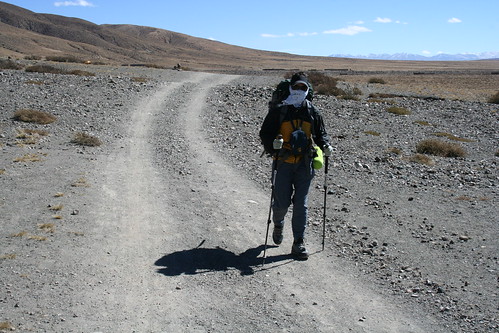 When we got into town, it was striking how dirty it is. How much the Chinese "communist" government is neglecting this place or trying to eradicate its people is astonishing. No running water, no electricity (well, the Chinese police building has electricity, but it is the only building in the area, everyone else has either a generator or nothing), plastic garbage everywhere... I walked to the 108 prayer wheels where we started and spun each one with a prayer.
When we got into town, it was striking how dirty it is. How much the Chinese "communist" government is neglecting this place or trying to eradicate its people is astonishing. No running water, no electricity (well, the Chinese police building has electricity, but it is the only building in the area, everyone else has either a generator or nothing), plastic garbage everywhere... I walked to the 108 prayer wheels where we started and spun each one with a prayer.
After washing up in the bowl in our room, I went to get lunch to bring back to Rod in bed. I saw the Corsican woman we met at the monastery last night. She is a bit crazy, but cool... a 50 year old woman hitchhiking through Tibet alone, and climbing high elevation mountains for a year in Pakistan, Tibet, and Nepal. Right on!
My first Kailash kora is finished. I'm not buzzing, but I do feel different somehow. I feel more peaceful. Who knows, maybe I will see how this effects me as I pay attention over time. It was certainly a powerful journey around a very powerful mountain.
Journal entry 10/28 : We left Darchen before dawn and drove in the cold until sunrise (8:45 sunrise - we are so far west but China refuses to do the time zone thing) and to lunch in Paryang. I had to stop a Chinese man who was throwing rocks at a cornered dog! We continued on in the hot afternoon sun to the town of Saga. The car overheated once, and the dust was terrible, but the ride beautiful. We got to listen to two new tapes! (Our driver only played one tape the whole ride to Darchen... over and over) In Saga we went to an internet cafe, then to dinner (with a bottle of wine!). The coveted electric blanket was so hot all night, and Rod was sick and kicking a lot.
Journal entry 10/29 : We left Saga early with the intention of making it to Shigatse tonight. Rod slept in the backseat most of the morning. Had lunch in an unknown town. I asked where the bathroom was and they said, "behind that building", I went there, no toilet or pit. Just go wherever... I peed by a cow. Trouble at one check point, and several stops to let the overheating Land Cruiser cool down made us late. We stopped in Lhatse for the night. 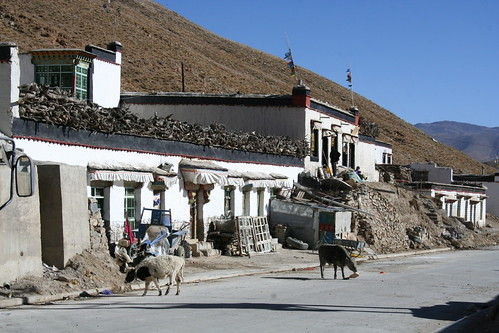
Journal entry 10/30 : Drove to Shigatse and I toured the Tashilhunpo Monastery, home of the Panchen Lama (at least traditionally- now he is kidnapped and held in Beijing). So cool! 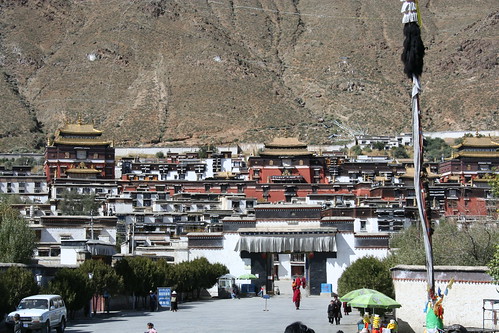 Rod stayed in the restaurant and the driver washed the car... Yes! Less dust! We then drove back to Lhasa, arriving after dark. Good to be back, took a hot shower! The Kailash trip ended, very good. We got some dinner and felt like old hats in Lhasa, knew people, knew where things are, etc. After dinner we walked the kora around the Jokhang Temple, then climbed to bed.
Rod stayed in the restaurant and the driver washed the car... Yes! Less dust! We then drove back to Lhasa, arriving after dark. Good to be back, took a hot shower! The Kailash trip ended, very good. We got some dinner and felt like old hats in Lhasa, knew people, knew where things are, etc. After dinner we walked the kora around the Jokhang Temple, then climbed to bed.
Many more photos - to see, click the photos link at the top right of the page, and go to the Kailash set!
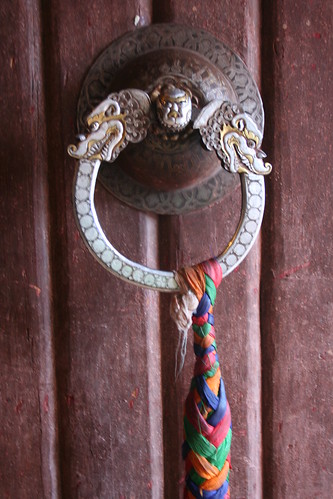

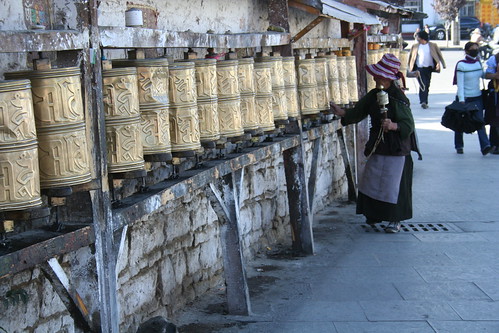
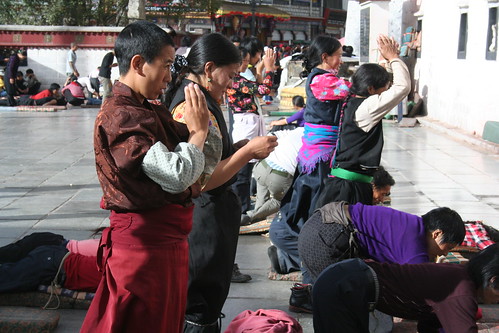

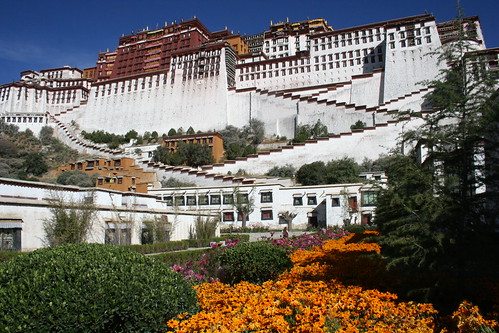 This palace, built in 7
This palace, built in 7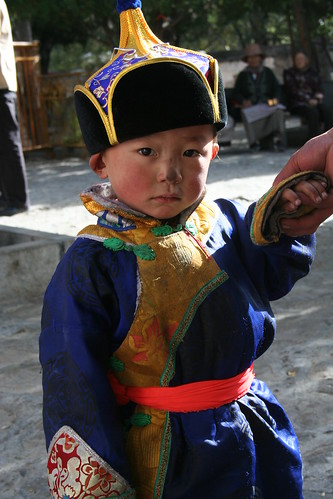 Childhood problems as simple as sleeplessness or as serious as a terminal illness can be cured by a blessing here. Rod and I asked for, and
Childhood problems as simple as sleeplessness or as serious as a terminal illness can be cured by a blessing here. Rod and I asked for, and 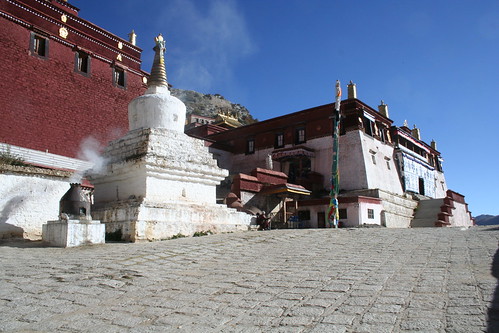 We walked the
We walked the 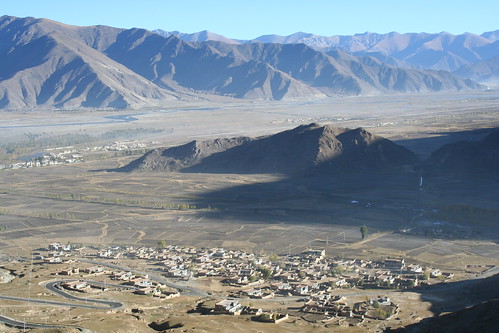
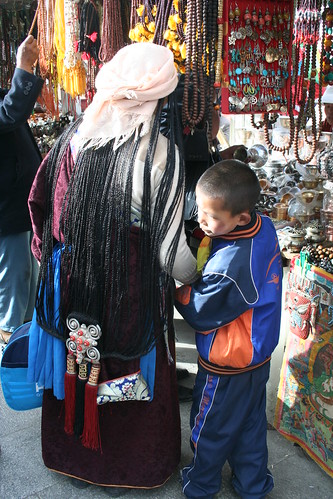
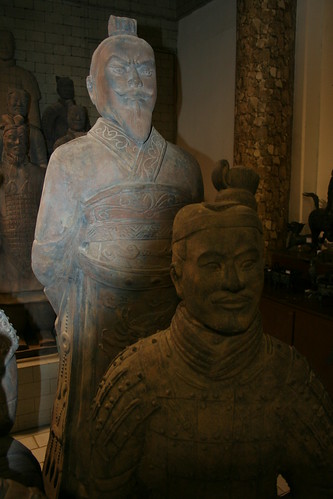 Each figure is unique, shaped after a real soldier in the First Qin Emperor's army. They were all buried to guard the Mausoleum of the Emperor. The figures vary in height according to their rank; the tallest being the Generals. The place is huge!
Each figure is unique, shaped after a real soldier in the First Qin Emperor's army. They were all buried to guard the Mausoleum of the Emperor. The figures vary in height according to their rank; the tallest being the Generals. The place is huge! 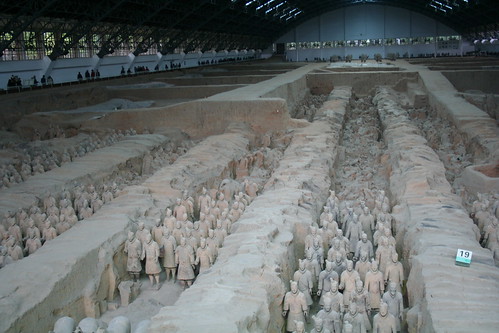
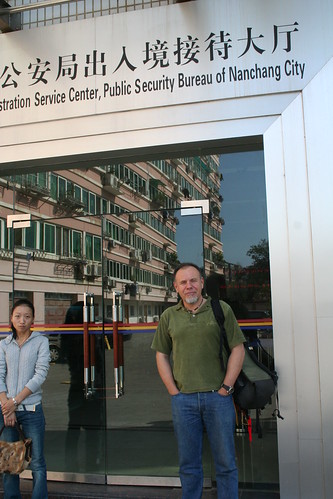
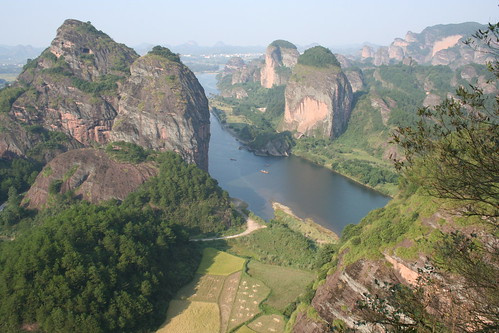

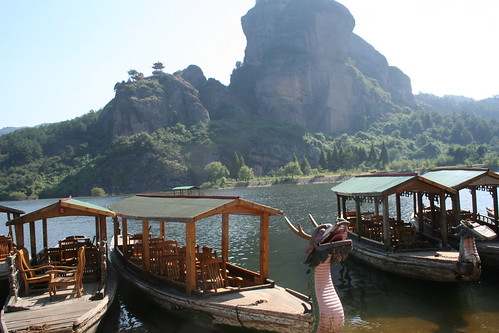 There were several men repairing longboats, and a desk where we paid our next fee for a boat ride up the river and to the various trailheads on our tourist map. We got boat tickets, and thought we would have a long boat to ourselves, but we were piled in with a Chinese tour group. Now, as mentioned in previous blogs, the Chinese have a different sense of appropriate volume. As we were polled up the quietly flowing river, in a small boat where normal voices could be heard easily, Rod and I almost pee'd our pants with what happened next. The tour guide stood up in the front of the boat, pulled out a megaphone, and began an extended natural history talk (in Chinese) at volume 11! It was too much!!
There were several men repairing longboats, and a desk where we paid our next fee for a boat ride up the river and to the various trailheads on our tourist map. We got boat tickets, and thought we would have a long boat to ourselves, but we were piled in with a Chinese tour group. Now, as mentioned in previous blogs, the Chinese have a different sense of appropriate volume. As we were polled up the quietly flowing river, in a small boat where normal voices could be heard easily, Rod and I almost pee'd our pants with what happened next. The tour guide stood up in the front of the boat, pulled out a megaphone, and began an extended natural history talk (in Chinese) at volume 11! It was too much!!
 High up on the cliff sides, the many caves were filled with wooden coffins and offerings. These tombs were used in the "Spring and Autumn Period(770-476 BC) and the Warring States Period(475-221 BC)". As is typical of major contemporary religious sites, what became known as a Taoist sacred site had already been sacred for the native religions of the area for a long time.
High up on the cliff sides, the many caves were filled with wooden coffins and offerings. These tombs were used in the "Spring and Autumn Period(770-476 BC) and the Warring States Period(475-221 BC)". As is typical of major contemporary religious sites, what became known as a Taoist sacred site had already been sacred for the native religions of the area for a long time. 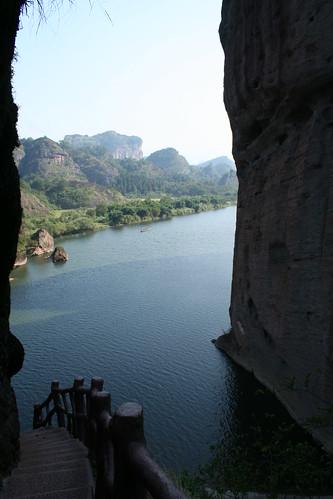
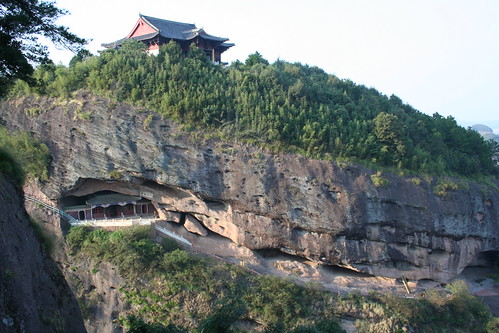
 This is a hugely powerful spot, both in spirituality and historical importance. And once again, China has made it into a sight seeing spot for tourists, aggressively attempting to turn its religious significance into an oddity of the past. In fact, in the Chinese approved travel and tourist information, it is entitled "The best natural archaeological museum of China by Our Beautiful Motherland".
This is a hugely powerful spot, both in spirituality and historical importance. And once again, China has made it into a sight seeing spot for tourists, aggressively attempting to turn its religious significance into an oddity of the past. In fact, in the Chinese approved travel and tourist information, it is entitled "The best natural archaeological museum of China by Our Beautiful Motherland".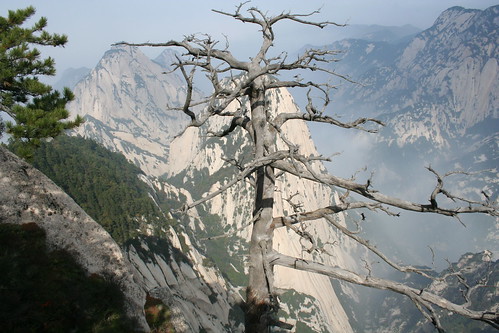 Chinese Emperors Tang Gaozhu and Tang Taizhong (Tang Dynasty) made famous journeys here. Taoists including Zhong Liquan, Lu Yan, Liu Chao, Wang Chuyi, Hao Datong, Tan Chuduan all once lived here. And, Chen Tuan, one of the founders of Taoism, spent 40 years on the mountain writing Taoist philosophy and reflections. The mountain is scattered with Temples and shrines, but at nothing near the density of precommunist time. Here and there you can spot a hermitage cave where a sage would sit and meditate, drink only spring water and eat gathered herbs, and live to be 500 years old (so they say). These caves are in the most difficult to reach places. Steps (little niches) carved into the vertical cliff faces climb up 10 to 30 meters, and there is a cave opening, or a long chain dangling from a little door high on a precipice.
Chinese Emperors Tang Gaozhu and Tang Taizhong (Tang Dynasty) made famous journeys here. Taoists including Zhong Liquan, Lu Yan, Liu Chao, Wang Chuyi, Hao Datong, Tan Chuduan all once lived here. And, Chen Tuan, one of the founders of Taoism, spent 40 years on the mountain writing Taoist philosophy and reflections. The mountain is scattered with Temples and shrines, but at nothing near the density of precommunist time. Here and there you can spot a hermitage cave where a sage would sit and meditate, drink only spring water and eat gathered herbs, and live to be 500 years old (so they say). These caves are in the most difficult to reach places. Steps (little niches) carved into the vertical cliff faces climb up 10 to 30 meters, and there is a cave opening, or a long chain dangling from a little door high on a precipice. 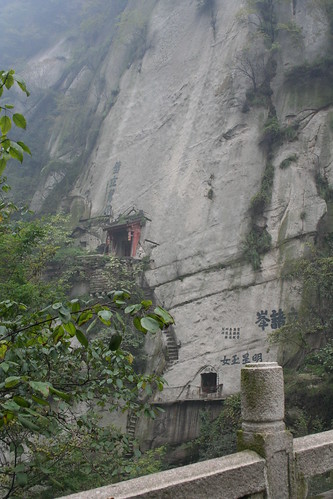 Interestingly, the princess Jinxian, the daughter of emperor Rui Zhong (Tang Dynasty), once came to Mount Hua to pursue Tao. I guess she lived in a cave, because afterward, emperor Tang Xuanzhong ordered the construction of Woman-Immortal Temple and Silver Cloud Monastery, making a specific space for women to study on the mountain.
Interestingly, the princess Jinxian, the daughter of emperor Rui Zhong (Tang Dynasty), once came to Mount Hua to pursue Tao. I guess she lived in a cave, because afterward, emperor Tang Xuanzhong ordered the construction of Woman-Immortal Temple and Silver Cloud Monastery, making a specific space for women to study on the mountain. 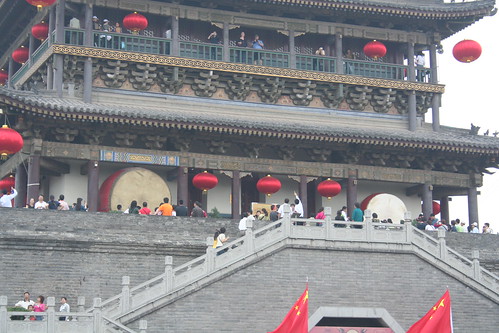 Our favorite section of the city is the Muslim quarter, where remnants of the Silk Road past are clustered inside street vendors and honking motor carts. The best food in the city can be found here, by far!
Our favorite section of the city is the Muslim quarter, where remnants of the Silk Road past are clustered inside street vendors and honking motor carts. The best food in the city can be found here, by far!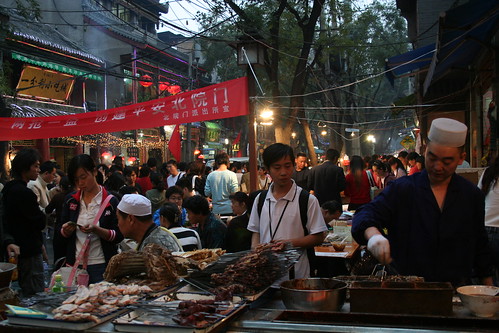
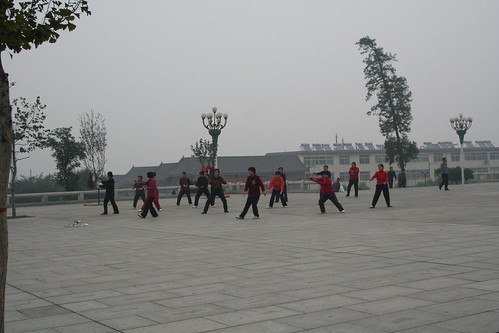 The temple's gardens have the architectural style of the classical gardens in south China; with a pond in the center and several pavilions around it. Beside the 'Huixin Rock' are the precipitous 370 rock steps called 'Qianchi Zhuang'. These are considered to be the primary "breath-taking path" of Mt. Huashan. It is called this because when walking up it, the narrow sliver of sky above the high walls makes you feel like you are at the bottom of a well.
The temple's gardens have the architectural style of the classical gardens in south China; with a pond in the center and several pavilions around it. Beside the 'Huixin Rock' are the precipitous 370 rock steps called 'Qianchi Zhuang'. These are considered to be the primary "breath-taking path" of Mt. Huashan. It is called this because when walking up it, the narrow sliver of sky above the high walls makes you feel like you are at the bottom of a well.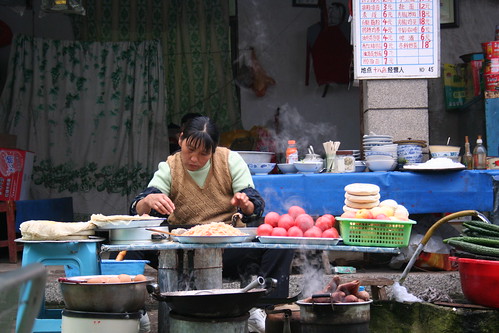 We buy red prayer sashes, and carry them with us to tie at the summits. The path is stairs, but toward the end, the stairs get steeper and there are chains to hold onto as you climb. The famous "ear touching wall", is a very narrow series of steep steps with a big chain.
We buy red prayer sashes, and carry them with us to tie at the summits. The path is stairs, but toward the end, the stairs get steeper and there are chains to hold onto as you climb. The famous "ear touching wall", is a very narrow series of steep steps with a big chain. 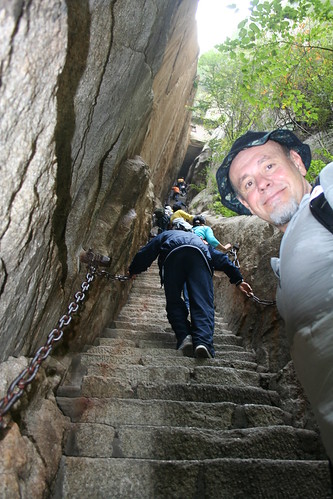 It's famed danger comes from (in my opinion) all the other climbers pushing their way up behind you and stumbling above you. When we finally reached the North Peak summit (1615m), Rod and I have had it with all the people and their lack of a sense of personal space. This peak is named "Clouds Stand" peak. The summit is a relatively flat peninsula of rock surrounded by cliffs on three sides, so it is classically thought of as a platform in the clouds (one you can stand on).
It's famed danger comes from (in my opinion) all the other climbers pushing their way up behind you and stumbling above you. When we finally reached the North Peak summit (1615m), Rod and I have had it with all the people and their lack of a sense of personal space. This peak is named "Clouds Stand" peak. The summit is a relatively flat peninsula of rock surrounded by cliffs on three sides, so it is classically thought of as a platform in the clouds (one you can stand on). 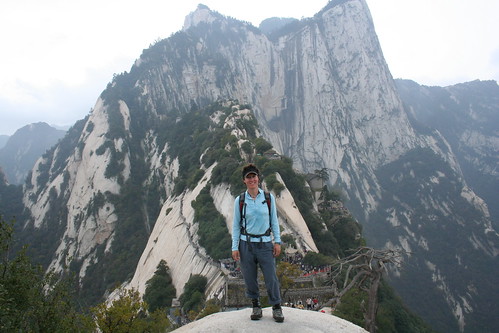 We try to enjoy the summit, Rod ties a prayer on a tree there, and we decide to call it a day. We will come back tomorrow, hope there are less people, and summit the other peaks. We stand in an agonizingly disorganized 45 min long line to take the cable car down. Yes, here too is a cable car! Everyone in the line cutting and pushing; Rod getting belligerent and swearing at people; basically Hot Sweaty Stinky Loud Chaos (for 45 min!). The good old china HSSLC.
We try to enjoy the summit, Rod ties a prayer on a tree there, and we decide to call it a day. We will come back tomorrow, hope there are less people, and summit the other peaks. We stand in an agonizingly disorganized 45 min long line to take the cable car down. Yes, here too is a cable car! Everyone in the line cutting and pushing; Rod getting belligerent and swearing at people; basically Hot Sweaty Stinky Loud Chaos (for 45 min!). The good old china HSSLC.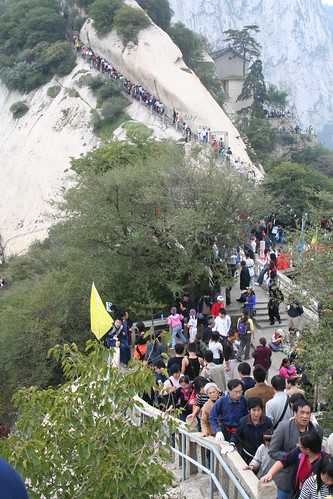 I bravely pushed on. I somehow got into turbo mode and charged my way through the crowds and up the Blue Dragon Range ridge. I was ruthless, climbing at about 1000 m/hr, passing and cutting people off... i don't feel good about it, it just happened. All the people - It was too much.
I bravely pushed on. I somehow got into turbo mode and charged my way through the crowds and up the Blue Dragon Range ridge. I was ruthless, climbing at about 1000 m/hr, passing and cutting people off... i don't feel good about it, it just happened. All the people - It was too much. 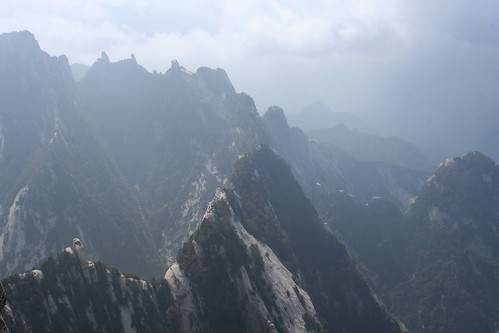 Then up the narrow ridge to the summit itself (2038m). On West Peak, or Lianhua Peak, is the Taois Cuiyun Palace. The rock before the temple looks like a lotus flower, hence the peak is named Lotus Flower Peak. There are another seven rocks beside Cuiyun Palace, and a big crack in one. This is said to be the place where Chenxiang, a filial young man, once ripped open the mountain to save his mother (The Heavenly Goddess San Sheng Mu).
Then up the narrow ridge to the summit itself (2038m). On West Peak, or Lianhua Peak, is the Taois Cuiyun Palace. The rock before the temple looks like a lotus flower, hence the peak is named Lotus Flower Peak. There are another seven rocks beside Cuiyun Palace, and a big crack in one. This is said to be the place where Chenxiang, a filial young man, once ripped open the mountain to save his mother (The Heavenly Goddess San Sheng Mu). 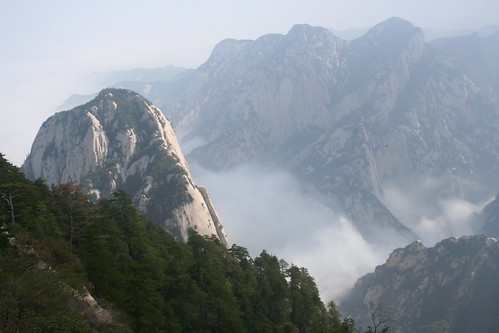 Legend has it that wild geese returning from the south often land here, giving the name 'Landing Wild Geese Peak', or 'Dropping Goose Peak'. The Taoist temple on South Peak is called Baidi Temple or Jintian Palace and is considered the host temple of Deity Shaohao.
Legend has it that wild geese returning from the south often land here, giving the name 'Landing Wild Geese Peak', or 'Dropping Goose Peak'. The Taoist temple on South Peak is called Baidi Temple or Jintian Palace and is considered the host temple of Deity Shaohao. 
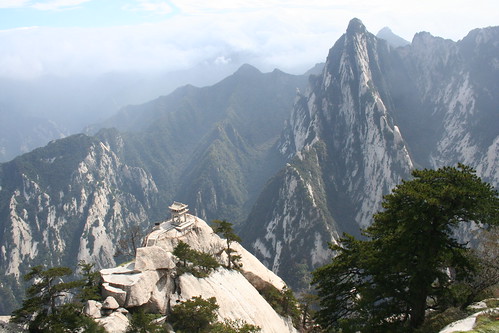 And, I can see the tops of the row of heads walking on Blue Dragon Range ridge below. I tie my prayer, hang out on this summit (2100m) a while, and enjoy the afternoon sunlight through the twisted pine trees. Quartz dikes on the cliff face look shaped into the form of a giant palm print, reminding me of the "Facing Sun" Peak's story. A long time ago, on March 3rd of the Lunar Calendar, a torrential flood erupted, destroying the villages within the Huashan area. This disaster was caused by the Queen Mother of the West, who held her 'Flat Peach Carnival' celebration that year. She carelessly spilled a little jade wine down from paradise, causing a serious flood below. This news was quickly reported by Deity Shaohao to the Jade Emperor in Celestial Paradise. He gave a prompt order to Deity Juling to go down to tame the flood. When Deity Juling, full of vigor and vitality, descended from the clouds, he arrived at the precipitous cliff of East Peak. At the moment that he laid his left hand on one side (the dikes) and his right leg on the other, he ripped the mountain into two halves and immediately the flood rushed out and away.
And, I can see the tops of the row of heads walking on Blue Dragon Range ridge below. I tie my prayer, hang out on this summit (2100m) a while, and enjoy the afternoon sunlight through the twisted pine trees. Quartz dikes on the cliff face look shaped into the form of a giant palm print, reminding me of the "Facing Sun" Peak's story. A long time ago, on March 3rd of the Lunar Calendar, a torrential flood erupted, destroying the villages within the Huashan area. This disaster was caused by the Queen Mother of the West, who held her 'Flat Peach Carnival' celebration that year. She carelessly spilled a little jade wine down from paradise, causing a serious flood below. This news was quickly reported by Deity Shaohao to the Jade Emperor in Celestial Paradise. He gave a prompt order to Deity Juling to go down to tame the flood. When Deity Juling, full of vigor and vitality, descended from the clouds, he arrived at the precipitous cliff of East Peak. At the moment that he laid his left hand on one side (the dikes) and his right leg on the other, he ripped the mountain into two halves and immediately the flood rushed out and away.